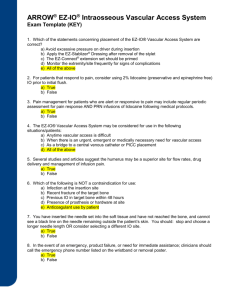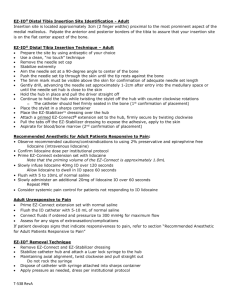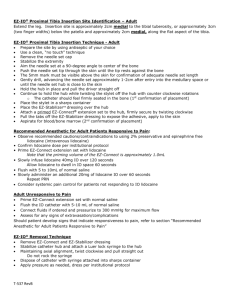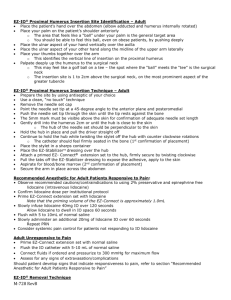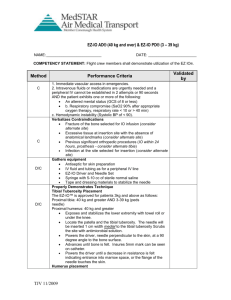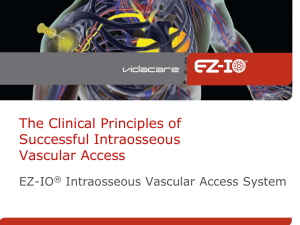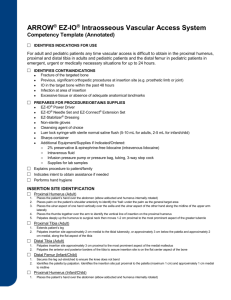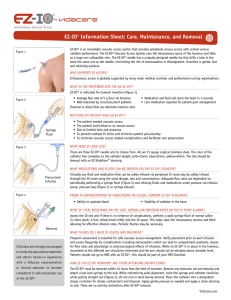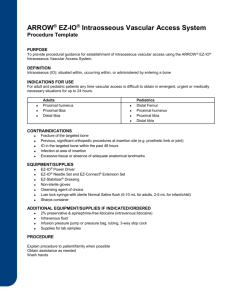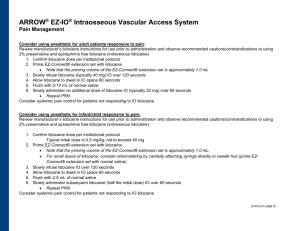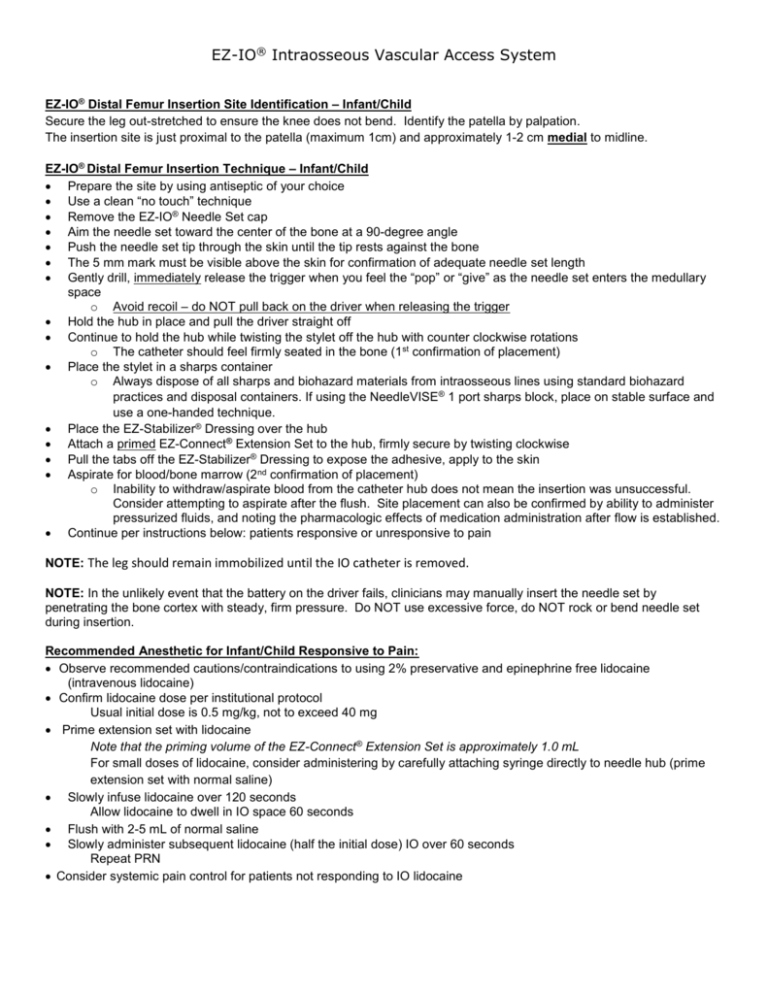
EZ-IO® Intraosseous Vascular Access System
EZ-IO® Distal Femur Insertion Site Identification – Infant/Child
Secure the leg out-stretched to ensure the knee does not bend. Identify the patella by palpation.
The insertion site is just proximal to the patella (maximum 1cm) and approximately 1-2 cm medial to midline.
EZ-IO® Distal Femur Insertion Technique – Infant/Child
Prepare the site by using antiseptic of your choice
Use a clean “no touch” technique
Remove the EZ-IO® Needle Set cap
Aim the needle set toward the center of the bone at a 90-degree angle
Push the needle set tip through the skin until the tip rests against the bone
The 5 mm mark must be visible above the skin for confirmation of adequate needle set length
Gently drill, immediately release the trigger when you feel the “pop” or “give” as the needle set enters the medullary
space
o Avoid recoil – do NOT pull back on the driver when releasing the trigger
Hold the hub in place and pull the driver straight off
Continue to hold the hub while twisting the stylet off the hub with counter clockwise rotations
o The catheter should feel firmly seated in the bone (1st confirmation of placement)
Place the stylet in a sharps container
o Always dispose of all sharps and biohazard materials from intraosseous lines using standard biohazard
practices and disposal containers. If using the NeedleVISE® 1 port sharps block, place on stable surface and
use a one-handed technique.
Place the EZ-Stabilizer® Dressing over the hub
Attach a primed EZ-Connect® Extension Set to the hub, firmly secure by twisting clockwise
Pull the tabs off the EZ-Stabilizer® Dressing to expose the adhesive, apply to the skin
Aspirate for blood/bone marrow (2nd confirmation of placement)
o Inability to withdraw/aspirate blood from the catheter hub does not mean the insertion was unsuccessful.
Consider attempting to aspirate after the flush. Site placement can also be confirmed by ability to administer
pressurized fluids, and noting the pharmacologic effects of medication administration after flow is established.
Continue per instructions below: patients responsive or unresponsive to pain
NOTE: The leg should remain immobilized until the IO catheter is removed.
NOTE: In the unlikely event that the battery on the driver fails, clinicians may manually insert the needle set by
penetrating the bone cortex with steady, firm pressure. Do NOT use excessive force, do NOT rock or bend needle set
during insertion.
Recommended Anesthetic for Infant/Child Responsive to Pain:
Observe recommended cautions/contraindications to using 2% preservative and epinephrine free lidocaine
(intravenous lidocaine)
Confirm lidocaine dose per institutional protocol
Usual initial dose is 0.5 mg/kg, not to exceed 40 mg
Prime extension set with lidocaine
Note that the priming volume of the EZ-Connect® Extension Set is approximately 1.0 mL
For small doses of lidocaine, consider administering by carefully attaching syringe directly to needle hub (prime
extension set with normal saline)
Slowly infuse lidocaine over 120 seconds
Allow lidocaine to dwell in IO space 60 seconds
Flush with 2-5 mL of normal saline
Slowly administer subsequent lidocaine (half the initial dose) IO over 60 seconds
Repeat PRN
Consider systemic pain control for patients not responding to IO lidocaine
EZ-IO® Intraosseous Vascular Access System
Infant/Child Unresponsive to Pain
Prime extension set with normal saline
Flush the IO catheter with 2-5 mL of normal saline
Connect fluids if ordered, infusion may need to be pressurized to achieve desired rate
Assess for any signs of extravasation/complications
Should patient develop signs that indicate responsiveness to pain, refer to section “Recommended Anesthetic for
Infant/Child Responsive to Pain”
EZ-IO® Catheter Removal Technique
Remove extension set and dressing
Stabilize catheter hub and attach a Luer lock syringe to the hub
Maintaining axial alignment, twist clockwise and pull straight out
o Do not rock the syringe
Dispose of catheter with syringe attached into sharps container
The use of any medication, including lidocaine, given IV or IO is the responsibility of the treating physician, medical
director or qualified prescriber and not an official recommendation of Teleflex. Teleflex is not the manufacturer of
lidocaine, and the user should be familiar with the manufacturer’s instructions or directions for use for all indications, sideeffects, contraindications, precautions and warnings of lidocaine. Teleflex disclaims all liability for the use, application or
interpretation of the use of this information in the medical treatment of any patient. Lidocaine dosing recommendations
were developed based on research; for additional information, please visit www.eziocomfort.com
This material is not intended to replace standard clinical education and training by Vidacare LLC, a subsidiary of Teleflex, Inc., and
should be utilized as an adjunct to more detailed information which is available about the proper use of the product. View educational
resources at www.teleflex.com/ezioeducation or contact a Teleflex clinical professional for any detailed questions related to product
insertion, maintenance, removal and other clinical education information.
Teleflex and EZ-IO are registered trademarks of Teleflex Incorporated or its affiliates.
© 2014 Teleflex Incorporated. All rights reserved. MC-000235 Rev 1

